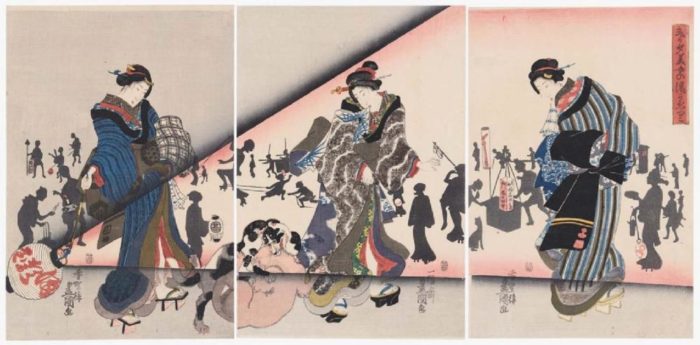Yukata was originally used to hide the skin when bathing. However, in the 17th century, a paid indoor sauna bath opened in Edo (Tokyo) and became popular, and bathers began bathing naked. On the other hand, sweating clothes after bathing were required.
The paid bathhouse was called “yuya”. The following ukiyoe depicts a bathhouse in which hot water is put in a large bathtub instead of a steam bath. Relaxing after bathing in a yukata and enjoying chatting with acquaintances.
The woman taking care of her guests was called “yuna”, and in the early days she also prostituted at the men’s bath. However, the men’s bath “yuna” was banned by the Tokugawa Shogunate.

The next ukiyoe shows a dressing room when the bathhouse became large and multiple baths became possible. The customer paid the entrance fee, undressed between the boards and washed herself in the washing place. And I entered into the bathtub. It’s about 270 cm square, so it’s not big. Not only a dressing room, but also magazines and posters on the second floor, it became a place for socializing and exchanging information. In the late 19th century, the structure changed drastically, and the bathtub grew like a hot spring.

If you look at the next two, you can see that the yukata is quite stylish. In Japan, hemp has been used for everyday wear for a long time, but at the same time of the spread of yuya, cotton began to be mass-produced nationwide. Cotton was superior to hemp in heat retention, softness, and ease of dyeing, and was suitable for yukata. The bathhouse itself was a place for socializing, and people began to walk outside with only yukata, so various types of yukata were made. In other words, yukata has become a new fashion.


However, outside of summer, it is to walk outside with a yukata. The following ukiyoe depicts women returning home from a bathhouse on a spring evening, wearing a striped kimono on a yukata like a coat. The lantern in her hand has fallen, and the three beautiful women are illuminated like by a searchlight. It is also interesting that people who go to the city are like silhouette.

When they returned home, they became only in yukata as dressing gown, and even turned them into sleepwear or namaki. Even as homes became equipped with baths, they continued to be used as bathrobes and sleepwear, but their production peaked at the time of the Tokyo Olympics in 1964, after which sleepwear was replaced by pajamas. However, from around 1990s, it was once again worn as fashionable summer clothing.
